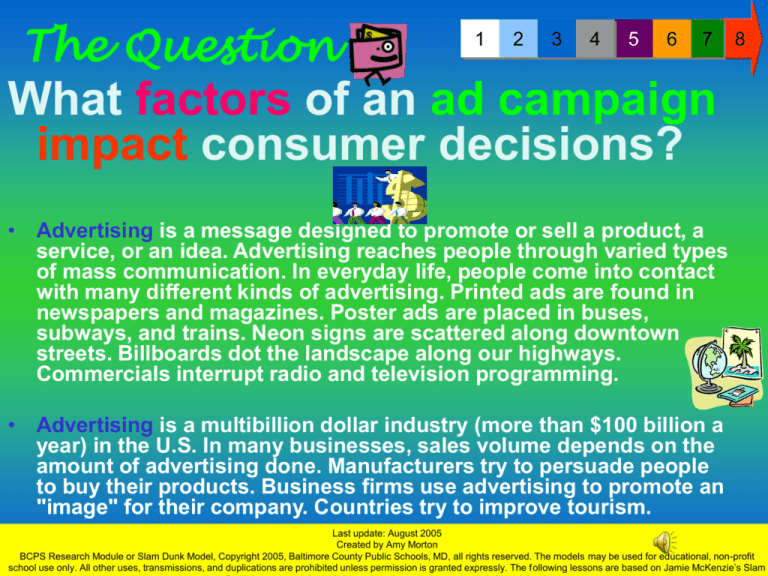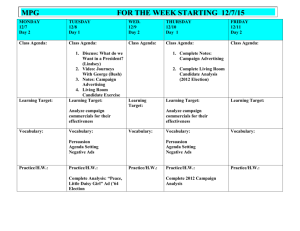
The Question
1
2
3
4
5
6
7
8
What factors of an ad campaign
impact consumer decisions?
• Advertising is a message designed to promote or sell a product, a
service, or an idea. Advertising reaches people through varied types
of mass communication. In everyday life, people come into contact
with many different kinds of advertising. Printed ads are found in
newspapers and magazines. Poster ads are placed in buses,
subways, and trains. Neon signs are scattered along downtown
streets. Billboards dot the landscape along our highways.
Commercials interrupt radio and television programming.
• Advertising is a multibillion dollar industry (more than $100 billion a
year) in the U.S. In many businesses, sales volume depends on the
amount of advertising done. Manufacturers try to persuade people
to buy their products. Business firms use advertising to promote an
"image" for their company. Countries try to improve tourism.
Last update: August 2005
Created by Amy Morton
BCPS Research Module or Slam Dunk Model, Copyright 2005, Baltimore County Public Schools, MD, all rights reserved. The models may be used for educational, non-profit
school use only. All other uses, transmissions, and duplications are prohibited unless permission is granted expressly. The following lessons are based on Jamie McKenzie’s Slam
1
Information Sources
•
‘Gotta’ go, gotta’ go, gotta’
go right now!....I’m lovin’
it... The quicker picker
upper.
Have you heard these slogans
before? Where?
As consumers, we shop in a
variety of stores for specific
things. Did you ever stop to
think what makes me want this
particular item from this
particular store?
This lesson will help students
understand how advertising
and marketing strategies
influence their economic
decision making.
•
•
2
3
4
5
6
7
VERB™ It’s what you do. is a national,
multicultural, social marketing
campaign* coordinated by the U.S.
Department of Health and Human
Services’ Centers for Disease Control
and Prevention (CDC).
Parents, partners, and professionals
who serve tweens can take advantage
of VERB’s reach to tweens and the
excitement the campaign is generating
among this age group to get moving!
This Web site includes resources and
information to make regular physical
activity “cool” for tweens and a fun
thing to do.
There are also VERB materials for
organizations that do not directly
provide programs to tweens but can
promote the importance of regular
physical activity for tweens, such as
through communications, advocacy,
policy change, and training of program
providers.
8
1
2
3
4
5
6
7
The Student Activity
The VERB campaign encourages young people ages 9–13 (tweens)
years to be physically active every day. The campaign combines paid
advertising, marketing strategies, and partnership efforts to reach the
distinct audiences of tweens and adults/influencers.
Day One
I. Successful Advertising Introduction
Click Here to review “What makes a successful ad campaign”
II. Ad Campaign Comparison & Analysis
While viewing the websites, you will compare
and analyze television and print ads.
Click Here for “Analyze the Ad Campaigns”
View the following websites:
http://www.cdc.gov/youthcampaign/general_market/index.htm
8
The Second Activity
1
2
3
4
5
6
7
8
Day Two
III. Motivation by Creation
A. Create two Verb Now ads.
Click here for “Create to Motivate.”
B. Target Audience:
Deep Creek Magnet School students.
Deep Creek Magnet School teachers.
C. Advertising Class Presentation.
Click here for “Presentation Rubric”
Verb Now Overview:
http://www.cdc.gov/youthcampaign/overview.htm
1
2
3
The Assessment Activity
4
5
6
Day One: Marketing Master
•
•
•
You have learned advertising and marketing strategies and compared
and analyzed a marketing campaign. Are you a Market Master?
A. List 3 ways advertisers attempt to market their goods or services.
B. Choose your favorite ad campaign from today’s lesson. Summarize
the ad you selected and explain why. Describe the propaganda
techniques and target audiences that were included in this ad.
Day Two: Creation Motivation Ad
•
•
•
•
A. Student participation during group work.
B. Student Presentation Review Sheet
C. Analyzing the Ad Campaign Exit Slip
D. Students' advertising campaigns will be formally assessed.
7
8
1
2
3
4
5
6
7
8
Enrichment Activity
1. Students will present their advertising campaigns as commercials
during the school announcements and/or students could have their
print ads appear in the quarterly parent newsletter.
2. Suppose you are a student member of the school Technology
Committee. The committee has been asked to present the pros and
cons of internet advertising to the PTA.
Write a paragraph to explain your position either pro or con. Be
sure to use what you know about propaganda techniques and
target audiences to support your position.
3. You are often asked to write to persuade in many content areas.
Apply what you know about Propaganda Techniques and how they
are used in advertising in order to evaluate if this website is
displaying an appropriate representation of their product/service.
Write a letter to persuade your peers to either use or not use this
website based on your knowledge of marketing strategies and
evaluation of the website.
1
2
3
4
5
Teacher Support Materials
•
•
•
•
•
•
MD STATE VOLUNTARY STATE CURRICULUM
Social Studies
4.0 ECONOMICS – Students will develop
economic reasoning to understand the
historical development and current status of
economic principles, institutions, and
processes needed to be effective citizens,
consumers, and workers participating in local
communities, the nation, and the world.
A. Scarcity and Economic Decision-making
2. Describe how scarcity of natural, human and
capital resources affects economic choices
producers and consumers make in the world
today.
b. Identify opportunity costs and trade offs in
decisions made in the production, distributions,
and consumption of goods and services.
6
7
8
1
2
3
4
5
6
7
More Teacher Support Materials
Objective(s):
Day One
Students will compare and analyze ad campaigns in order to evaluate advertising and marketing
strategies.
Day Two
Students will apply advertising and marketing strategies in order to create an ad campaign.
Overarching Question: How does scarcity of natural, human and capital resources affect economic
choices producers and consumer make in the world today?
Differentiation:
•
Provide text with highlighted information from websites.
•
Pair Share students according to reading ability.
•
During comparison activity have pre-selected materials prepared.
Time Management Strategies:
•
This lesson is 2 (45 minute) lessons.
•
Extended Activities can be completed at home.
Learning Styles/Preferences: Field Dependent
•
Auditory/Verbal-Linguistic Intelligence/Kinesthetic/Visual /Tactile/Active Learners
AVID Strategies: Socratic Seminar, Evaluation, Respond, Collaborative, Pair Share
8



